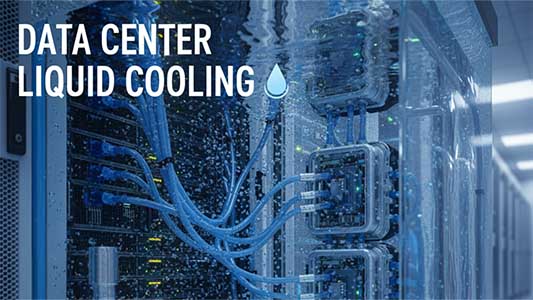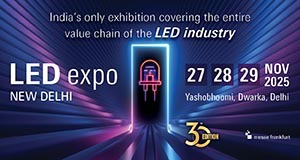As compute power increases due to AI, high-performance computing and hyperscale cloud data centers are dealing with far larger heat densities than before. In 2025, liquid cooling has progressed from experimental to strategic; it is being chosen to improve performance, reduce energy use, and satisfy sustainability goals. This blog discusses the key trends influencing liquid cooling today and concludes with a brief market snapshot to put the momentum in context.
Market size and growth:
In recent years the global liquid cooling market for data centers has reached the low single-digit billions of US dollars. Specifically, in 2024 the market was valued at approximately US$2.80 billion. Projections indicate strong expansion through the decade: the market is expected to grow to around US$13.05 billion by 2032, representing a compound annual growth rate (CAGR) of roughly 21.2% in the 2025–2032 period.
Regionally, North America leads adoption today, driven by rapid AI infrastructure build-outs, large cloud providers and early investments in high-density compute. Within immersion cooling, single-phase systems already account for the majority share over 55% of the immersion segment in recent measurements reflecting their operational advantages in many real deployments.
Why liquid cooling matters now
Air cooling becomes difficult as rack power densities increase. Liquid cooling, whether direct-to-chip, single-phase, or two-phase immersion, removes heat significantly more efficiently, resulting in higher sustained performance, fewer thermal hotspots, and increased hardware longevity. For enterprises that rely on consistent peak throughput, liquid cooling allows CPUs to function at maximum speed without thermal throttling.
1. Liquid cooling becomes mission-critical for high-density workloads
Data center operators are increasingly treating liquid cooling as essential infrastructure rather than an optional add-on. Modern AI training clusters and HPC racks produce thermal loads that air systems struggle to shed effectively. Liquid cooling methods especially direct-to-chip and immersion are able to handle much higher rack power densities, reduce hot spots, and keep hardware within optimal temperature ranges. The practical result: better reliability and higher usable compute per rack.
2. Single-phase immersion gains wide adoption
Among immersion options, single-phase systems have seen particularly strong uptake. Their relative simplicity, operational reliability and easier integration with existing server designs make them an attractive first step for many operators. In practice, single-phase immersion delivers the thermal advantages of immersion cooling while minimizing the engineering and maintenance complexity that can accompany two-phase systems. For many new deployments and retrofits, single-phase has become the default immersion choice.
3. Direct-to-chip cooling scales for performance and precision
Direct-to-chip cooling where coolant interfaces directly with CPUs, GPUs or other hot components continues to scale across hyperscale and enterprise environments. Its precision cooling lets data centers maintain closer thermal margins, enabling denser configurations and sustained high performance without thermal throttling. This method is particularly appealing for workloads where consistent peak throughput is critical, such as inference and large-scale model training.
4. Immersion + direct cooling hybrid approaches emerge
Operators are increasingly combining cooling strategies to match diverse workloads: immersion for whole-server thermal control and direct-to-chip for the hottest nodes inside a rack. These hybrid strategies allow teams to balance cost, complexity and performance, applying the most appropriate technique where it yields the best return on investment.
5. Sustainability and energy efficiency drive buying decisions
Energy efficiency and carbon reduction remain core drivers for liquid cooling adoption. Liquid systems can lower power usage effectiveness (PUE), cut chiller workloads, and reduce the overall energy footprint of a facility. Designs that tolerate higher coolant temperatures or reduce auxiliary system power are especially attractive as are solutions that enable heat reuse or more efficient heat rejection. For many organizations, liquid cooling supports regulatory targets and corporate sustainability commitments as much as it improves thermal performance.
6. Fluid and component innovation becomes a competitive edge
Beyond architecture, improvements in coolant formulations and thermal components are important trendlines. New fluid chemistries focus on longer service life, reduced corrosion risk, and stable thermal performance. Likewise, improvements in coolant distribution units, seals, and leak-detection systems reduce operational risk and lower maintenance effort. These material and component advances make liquid cooling more dependable and easier to operate at scale.
7. Systems designed for higher inlet/supply temperatures reduce energy costs
A growing design focus is systems that operate effectively at higher coolant or inlet temperatures. Allowing higher supply temperatures reduces or eliminates the need for energy-intensive chillers in many climates, lowering operating costs and simplifying plant design. This trend aligns directly with sustainability goals and improves the economics of liquid cooling deployments.
8. Retrofitting challenges shape adoption strategy
While liquid cooling is compelling, retrofit complexity remains a major consideration. Converting an air-cooled facility can require new plumbing, coolant distribution infrastructure, leak prevention measures and layout changes. These capital and operational hurdles push many organizations to weigh new builds or targeted retrofit pilots over wholesale conversion. The result is a measured rollout approach: pilots, targeted racks and greenfield sites first, followed by broader adoption once ROI and processes are proven.
9. Edge and hyperscale each demand different approaches
Hyperscale operators often pursue immersion and direct solutions to maximize density and efficiency, while edge deployments emphasize compact, low-maintenance systems that can operate in constrained environments. Vendors and operators are responding with product variants tailored to each use case: ruggedized, low-touch solutions for the edge and highly integrated, high-capacity solutions for hyperscale and HPC.
10. Vendor innovation and ecosystem expansion accelerate readiness
The vendor landscape is maturing rapidly. Established infrastructure firms and specialized liquid-cooling companies are expanding portfolios adding CDUs, fluid management tools, and integrated rack solutions. This broader ecosystem reduces integration risk for data center teams and accelerates time to production for liquid-cooled sites.
Practical takeaways for data center planners
- Match cooling to workload: use direct-to-chip or immersion where density and consistent performance matter.
- Start with pilots: validate coolant choices, leak-management and maintenance procedures before scaling.
- Consider total cost of ownership: upfront retrofit costs can be offset by operational savings in energy and higher compute density.
- Design for sustainability: choose systems that permit higher inlet temperatures and easier heat reuse to maximize environmental benefits.
Conclusion — liquid cooling as a strategic platform
By 2025, liquid cooling is no longer a niche experiment: it is a strategic platform for data centers that need to balance ever-higher compute demands with energy cost control and sustainability targets. Trends such as single-phase immersion adoption, direct-to-chip scaling, fluid innovation, and systems that tolerate higher operating temperatures point to an industry that’s rapidly professionalizing liquid cooling practices. For planners, the message is clear: evaluate workloads, prioritize pilots, and consider liquid cooling as a central part of future data center strategy—not just for thermal control, but for competitiveness and long-term resilience.












